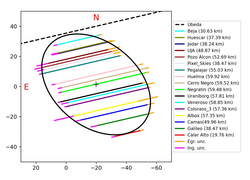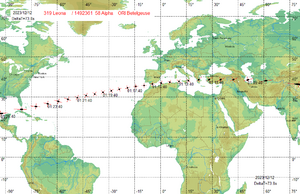Astronomy:319 Leona
 The outline of Leona's shape revealed in a stellar occultation from 13 September 2023 | |
| Discovery [1] | |
|---|---|
| Discovered by | A. Charlois |
| Discovery site | Nice Obs. |
| Discovery date | 8 October 1891 |
| Designations | |
| (319) Leona | |
| Pronunciation | /liːˈoʊnə/[4] |
| Named after | unknown Leona[2] |
| A920 HE | |
| Minor planet category | main-belt · (outer) [1][3] |
| Orbital characteristics [1] | |
| Epoch 4 September 2017 (JD 2458000.5) | |
| Uncertainty parameter 0 | |
| Observation arc | 125.32 yr (45,774 days) |
| |{{{apsis}}}|helion}} | 4.1451 AU |
| |{{{apsis}}}|helion}} | 2.6655 AU |
| 3.4053 AU | |
| Eccentricity | 0.2172 |
| Orbital period | 6.28 yr (2,295 days) |
| Mean anomaly | 21.414° |
| Mean motion | 0° 9m 24.48s / day |
| Inclination | 10.564° |
| Longitude of ascending node | 184.95° |
| 228.27° | |
| Physical characteristics | |
| Dimensions | 79.6 km × 54.8 km (± 2.2 km × 1.3 km)[5] |
| Mean diameter | 66±2 km[5] |
| Rotation period | 430±2 h[6] |
| Geometric albedo | 0.085±0.005[1][7] |
| P [8] · X [9] · C [3] | |
| Absolute magnitude (H) | 10.21[1][10] 10.46±0.06[6] |
319 Leona (provisional designation A920 HE) is a dark, carbonaceous asteroid in the outer regions of the asteroid belt. It was discovered on 8 October 1891, by French astronomer Auguste Charlois at Nice Observatory in France .[10] On 12 December 2023, Leona passed in front of the bright star Betelgeuse and occulted it, which caused the star to briefly dim from Central America, Europe, and east Asia.[11] This occultation was expected to reveal the shape of Leona and the surface of Betelgeuse in high detail.
Classification and orbit
Leona orbits the Sun in the outer main-belt at a distance of 2.7–4.1 AU once every 6 years and 3 months (2,295 days). Its orbit has an eccentricity of 0.22 and an inclination of 11° with respect to the ecliptic.[1]
Physical characteristics
Spectral type
Leona has been characterized as a dark and reddish P-type asteroid by the Wide-field Infrared Survey Explorer (WISE), and as an X-type asteroid by Pan-STARRS photometric survey.[8] The Collaborative Asteroid Lightcurve Link groups it to the carbonaceous C-type asteroids.[3]
Slow rotator and tumbler
In October 2016, a rotational lightcurve of Leona was obtained from photometric observations by astronomers Frederick Pilcher (see naming cite for 1990 Pilcher) at Organ Mesa Observatory (G50), United States, Lorenzo Franco at Balzaretto Observatory (A81), Italy, and Petr Pravec at the Ondřejov Observatory, Czech Republic. Lightcurve analysis gave a well-defined rotation period of 430±2 hours with a brightness variation of 0.5 magnitude ({{{1}}}).[6]
This makes Leona one of the Top 100 slowest rotators known to exist. The astronomers also detected a non-principal axis rotation seen in distinct rotational cycles in successive order. This tumbling also gives an alternative candidate period solution of 1084±10 hours, one of the longest periods ever measured.[6] It is the third-largest tumbler known to exist (also see List of tumblers).
Previous observations of Leona gave a much shorter period between 6 and 15 hours,[12][13] which demonstrates the intricacy when observing slow rotators, especially those with a tumbling motion. A detailed description of the procedure of the photometric measurement is given by Pilcher.[6]
Diameter and albedo
According to the surveys carried out by the Japanese Akari satellite and the NEOWISE mission of NASA's WISE space-telescope, Leona measures between 49.943 and 89.00 kilometers in diameter and its surface has an albedo between 0.02 and 0.085.[7][8][14][15] CALL derived an albedo of 0.0318 and a diameter of 67.97 kilometers based on an absolute magnitude of 10.2.[3]
Naming
The origin of this minor planet's name is unknown.[2]
Among the many thousands of named minor planets, Leona is one of 120 asteroids for which no official naming citation has been published. All of these low-numbered asteroids have numbers between 164 Eva and 1514 Ricouxa and were discovered between 1876 and the 1930s, predominantly by astronomers Auguste Charlois, Johann Palisa, Max Wolf and Karl Reinmuth.[16]
2023 occultation of Betelgeuse
Predicted path of the occultation of Betelgeuse by (319) Leona on 12 December 2023, using the SOLEX software
On 12 December 2023 at about 01:09–01:27 UT, Leona occulted Betelgeuse as seen from southern Europe, Turkey, Greece and Sicily.[11] The 14th magnitude asteroid was predicted to occult Betelgeuse approximately 12 seconds; Betelgeuse was expected to dim by about 3 magnitudes.[17] The prediction was at first uncertain, visible on a very narrow path on Earth's surface, its width and location being uncertain due to lack of precise knowledge of the size and path of the asteroid).[18] Projections were later refined as more data were analyzed for[19] a totality ("ring of fire") of approximately five seconds on a 60 km wide path stretching from China, Tajikistan, Armenia, Turkey, Greece, Italy, Spain, the Atlantic Ocean, Miami, Florida and the Florida Keys to parts of Mexico.[20] Among other programmes 80 amateur astronomers in Europe alone were coordinated by astrophysicist Miguel Montargès, et al. of the Paris Observatory for the event.[21] Light curve studies of the event was expected to help understand the distribution of brightness down to the granular level of Beltegeuse's convection cells,[22] thus providing detailed data on the giant star heretofor inaccessible.
Observations of the earlier September 2023 occultation showed that the asteroid was slightly elliptical; a preliminary 3D model of Leona was able to be constructived. Leona is approximately 80 by 55 kilometres, hence is projected to have a silhouette of roughly 46 by 41 milliarcseconds (mas).[5][23] Betelgeuse has an apparent size in the sky of about 40 mas, but its diffuse atmosphere may make it appear 50 mas in size. A preliminary analysis of results showed only a slight dimming.
| This astronomy needs to be updated. Please update this astronomy to reflect recent events or newly available information. (December 2023) |
If Betelgeuse appears to be that much larger than Leona, then its light won't be completely obscured. If the eclipse is complete there will be a narrow strip of several kilometres wide wherein the star will completely disappear for 5–15 seconds.[22]
References
- ↑ 1.0 1.1 1.2 1.3 1.4 1.5 "JPL Small-Body Database Lookup: 319 Leona (A891 TA)". Jet Propulsion Laboratory. https://ssd.jpl.nasa.gov/tools/sbdb_lookup.html#/?sstr=2000319. Retrieved 11 December 2023.
- ↑ 2.0 2.1 Schmadel, Lutz D. (2007). "(319) Leona". Dictionary of Minor Planet Names – (319) Leona. Springer Berlin Heidelberg. p. 42. doi:10.1007/978-3-540-29925-7_320. ISBN 978-3-540-00238-3.
- ↑ 3.0 3.1 3.2 3.3 "LCDB Data for (319) Leona". Asteroid Lightcurve Database (LCDB). http://www.minorplanet.info/PHP/generateOneAsteroidInfo.php?AstInfo=319%7CLeona.
- ↑ Noah Webster (1884) A Practical Dictionary of the English Language
- ↑ 5.0 5.1 5.2 Ortiz, J. L.Expression error: Unrecognized word "etal". (November 2023). "The stellar occultation by (319) Leona on 13 September 2023 in preparation for the occultation of Betelgeuse". Monthly Notices of the Royal Astronomical Society: Letters: 7. doi:10.1093/mnrasl/slad179. slad179. Bibcode: 2023MNRAS.tmpL.172O.
- ↑ 6.0 6.1 6.2 6.3 6.4 Pilcher, Frederick; Franco, Lorenzo; Pravec, Petr (April 2017). "319 Leona and 341 California - Two Very Slowly Rotating Asteroids". The Minor Planet Bulletin 44 (2): 87–90. ISSN 1052-8091. Bibcode: 2017MPBu...44...87P. http://www.minorplanet.info/MPB/MPB_44-2.pdf. Retrieved 26 July 2017.[yes|permanent dead link|dead link}}]
- ↑ 7.0 7.1 Masiero, Joseph R.; Grav, T.; Mainzer, A. K.; Nugent, C. R.; Bauer, J. M.; Stevenson, R. et al. (August 2014). "Main-belt Asteroids with WISE/NEOWISE: Near-infrared Albedos". The Astrophysical Journal 791 (2): 11. doi:10.1088/0004-637X/791/2/121. Bibcode: 2014ApJ...791..121M. http://adsabs.harvard.edu/cgi-bin/bib_query?bibcode=2014ApJ...791..121M. Retrieved 26 July 2017.
- ↑ 8.0 8.1 8.2 Mainzer, A.; Grav, T.; Masiero, J.; Hand, E.; Bauer, J.; Tholen, D. et al. (November 2011). "NEOWISE Studies of Spectrophotometrically Classified Asteroids: Preliminary Results". The Astrophysical Journal 741 (2): 25. doi:10.1088/0004-637X/741/2/90. Bibcode: 2011ApJ...741...90M.
- ↑ Veres, Peter; Jedicke, Robert; Fitzsimmons, Alan; Denneau, Larry; Granvik, Mikael; Bolin, Bryce et al. (November 2015). "Absolute magnitudes and slope parameters for 250,000 asteroids observed by Pan-STARRS PS1 - Preliminary results". Icarus 261: 34–47. doi:10.1016/j.icarus.2015.08.007. Bibcode: 2015Icar..261...34V. http://adsabs.harvard.edu/cgi-bin/bib_query?bibcode=2015Icar..261...34V. Retrieved 26 July 2017.
- ↑ 10.0 10.1 "(319) Leona = 1891 TA = 1920 HE". Minor Planet Center. https://www.minorplanetcenter.net/db_search/show_object?object_id=319. Retrieved 26 July 2017.
- ↑ 11.0 11.1 Denissenko, Denis (3 October 2004). "Unique occultations". http://hea.iki.rssi.ru/~denis/special.html.
- ↑ Cite error: Invalid
<ref>tag; no text was provided for refs namedgeneva-obs - ↑ Alkema, Michael S. (October 2013). "Asteroid Lightcurve Analysis at Elephant Head Observatory: 2013 April-July". The Minor Planet Bulletin 40 (4): 215–216. ISSN 1052-8091. Bibcode: 2013MPBu...40..215A. http://adsabs.harvard.edu/cgi-bin/bib_query?bibcode=2013MPBu...40..215A. Retrieved 26 July 2017.
- ↑ Usui, Fumihiko; Kuroda, Daisuke; Müller, Thomas G.; Hasegawa, Sunao; Ishiguro, Masateru; Ootsubo, Takafumi et al. (October 2011). "Asteroid Catalog Using Akari: AKARI/IRC Mid-Infrared Asteroid Survey". Publications of the Astronomical Society of Japan 63 (5): 1117–1138. doi:10.1093/pasj/63.5.1117. Bibcode: 2011PASJ...63.1117U. (online, AcuA catalog p. 153)
- ↑ Nugent, C. R.; Mainzer, A.; Bauer, J.; Cutri, R. M.; Kramer, E. A.; Grav, T. et al. (September 2016). "NEOWISE Reactivation Mission Year Two: Asteroid Diameters and Albedos". The Astronomical Journal 152 (3): 12. doi:10.3847/0004-6256/152/3/63. Bibcode: 2016AJ....152...63N.
- ↑ Cite error: Invalid
<ref>tag; no text was provided for refs namedDOMPN-unknown - ↑ Steve Preston. "Asteroidal Occultation Prediction: (319)Leona". Asteroid Occultation Updates. https://www.asteroidoccultation.com/2023_12/1212_319_82912.htm. Retrieved 2023-06-16. hal-astro-lab
- ↑ Sigismondi, Costantino (2020). "The partial asteroidal occultation of Betelgeuse on Jan 2, 2012". Gerbertvs 13: 25. Bibcode: 2020Gerb...13...25S.
- ↑ "IOTA-ES". https://www.iota-es.de/betelgeuse2023.html.
- ↑ https://www.theguardian.com/science/2023/dec/08/eclipse-betelgeuse-star-asteroid
- ↑ https://www.msn.com/en-us/travel/news/betelgeuse-one-of-the-brightest-stars-in-the-sky-will-almost-disappear-next-week-heres-how-to-see-it/ar-AA1l9jJK
- ↑ 22.0 22.1 Hattenbach, Jan (12 November 2023). "ASTEROID WILL COVER BETELGEUSE, MAY REVEAL ITS VISIBLE SURFACE". https://skyandtelescope.org/astronomy-news/asteroid-will-cover-betelgeuse-may-reveal-its-visible-surface/.
- ↑ "(319) Leona - physical model to predict the occultation of Betelgeuse". https://sirrah.troja.mff.cuni.cz/~durech/Leona/.
External links
- Asteroid Lightcurve Database (LCDB), query form (info )
- Dictionary of Minor Planet Names, Google books
- Asteroids and comets rotation curves, CdR – Observatoire de Genève, Raoul Behrend
- Discovery Circumstances: Numbered Minor Planets (1)-(5000) – Minor Planet Center
- 319 Leona at AstDyS-2, Asteroids—Dynamic Site
- 319 Leona at the JPL Small-Body Database
 |


